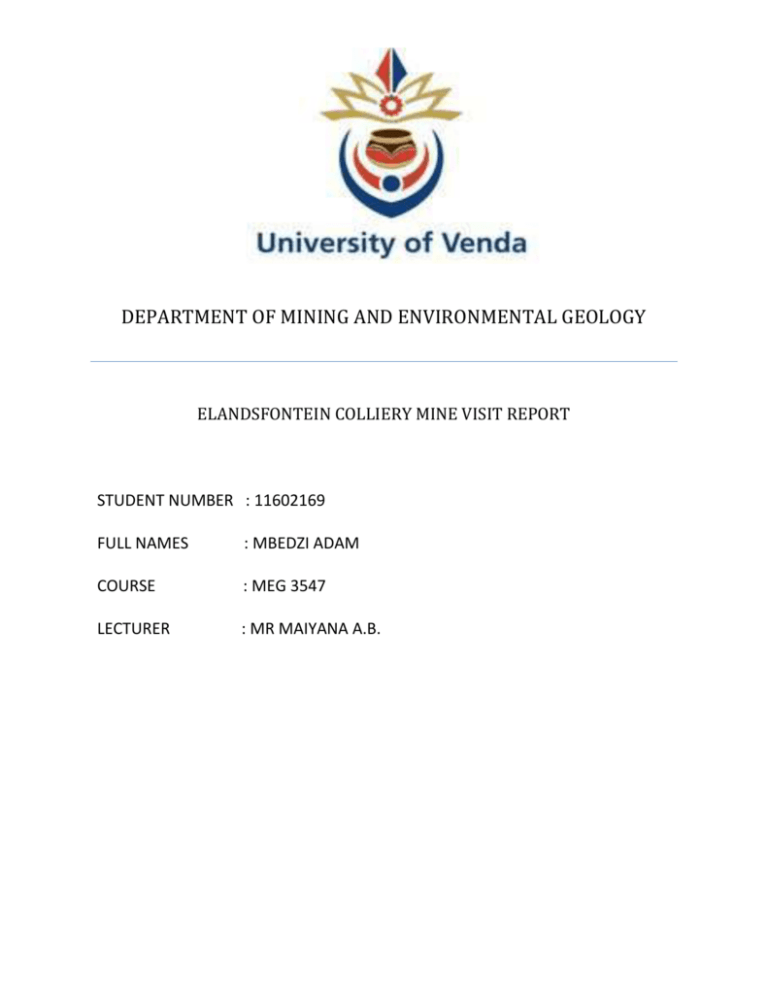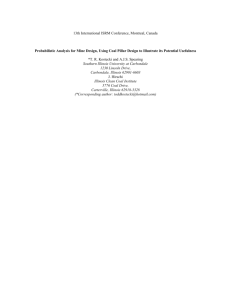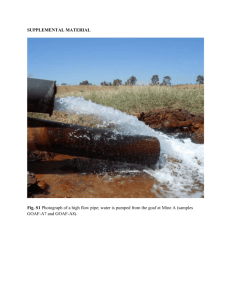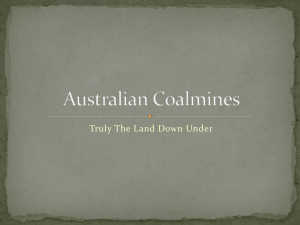
DEPARTMENT OF MINING AND ENVIRONMENTAL GEOLOGY
ELANDSFONTEIN COLLIERY MINE VISIT REPORT
STUDENT NUMBER : 11602169
FULL NAMES
: MBEDZI ADAM
COURSE
: MEG 3547
LECTURER
: MR MAIYANA A.B.
1
CONTENTS………………………………………………………………………PAGES
1. Introduction………………………………………………………………………………………. 2
2. Purpose of the visit……………………………………………………………………………. 2
3. Geology of the area…………………………………………………………………………….3
3.1. Stratigraphy………………………………………………………………………………… 3
3.2. Mine water evolution…………………………………………………………………. 4
4. Mining method and commodity………………………………………………………… 4
5. Production operation………………………………………………………………………… 5
6. Conclusion…………………………………………………………………………………………. 6
7. Recommendations…………………………………………………………………………….. 7
8. References………………………………………………………………………………………….8
All rights reserved © 2012
2
1. Introduction
The visit as a whole was aimed at visiting the Elandsfontein Colliery Mine as a whole or one
operation and its sectors. The operation relates to or otherwise corresponds to a medium-scale
operation. Elandsfontein Colliery Mine is located in the south-west of Witbank near Clewer found
in the western part of Mpumalanga Province. The area is actually categorized under the Witbank
Coalfields and partly of the Highveld Coalfields of Mpumalanga, South Africa where most of the
country’s coal is recovered, and the mine is owned by Anker Coal and Mineral Holdings SA (Pty)
Ltd. The operation is in a farm, and besides it is also surrounded by very sensitive areas, these
include the Witbank Nature Reserve, Ezemvelo Private Nature Reserve, Clewer residential area
and others. The area encircled in the map below is where the Elandsfontein Colliery Mine
operations are located.
Figure 1
2. Purpose of the visit
All rights reserved © 2012
3
The main purpose of the visit was to explore the mining operation as to relate with acquired
academic knowledge from different sectors in a mine as presented in each specificity of the
module content up to our level of study but with special attention to those that relate closely to
integrated mine water management as a module. This was also to familiarize us with the
practical world of our degree as a whole, in order to facilitate the comprehension of all theoretical
implication of the mining operation as a system and all its related sectors. In addition, the visit
was also a means of acquiring new information that cannot be expressed theoretically which is
useful for our educational development and career advancement; this was also to give us the
recent information or otherwise current challenges that are not yet documented as to how to
address them or how they are generated. The secondary purpose was to enhance our interests
as graduates to our working environment as future professionals and also to improve the way we
relate to each other in the field.
3. Geology of the area
The geology of Mpumalanga Province as a whole is very much of economic importance as it is
characterized by vast majority of geological formation and complexes with distinct features such
as Barberton greenstone belt, Bushveld Igneous Complex and others, but the main focus on this
will be that of the stratigraphy of the Witbank Coalfield and Highveld Coalfields, and as attribute
to integrated mine water management as a module, the mine water evolution of the Highveld
Coalfields will also be discussed to review the changes in approach to mine water management
of the area.
3.1.
Stratigraphy
The Witbank Coalfield is situated east of Johannesburg, and Highveld Coalfield is situated south
of the Witbank Coalfield. The fields are characterized by numerous post-Karoo age dolerite sills
and dykes, and rocks of the Vryheid Formation of the Ecca Group cover most of the area. Five
separate bituminous coal seams are preserved in the Vryheid Formation, deposited under cool,
wet climatic conditions. The Witbank Coalfield consists primarily of sandstone, carbonaceous
shale, siltstone and minor conglomerate. The sediments were deposited on an undulating floor,
which influenced the distribution and thickness of the sedimentary successions as well as the
quality of coal seams. The distribution of the coal seams is controlled by the pre-Karoo
topography, but the coals are mainly flat-lying or dip only slightly in a southerly direction. Steeper
dips are encountered in the lower seams, while seams numbers 4 and 5 have a regular deposition.
The strata of the Karoo are generally undeformed, but have abundant small faults. Dolerite dykes
and sills have affected most of the areas of the coalfields. Large sections of the coal seams have
been devolatilized, and are rendered inapt for mining purposes (Smith and Whittaker, 1986).
All rights reserved © 2012
4
3.2.
Mine water evolution
Highveld Coalfields is located within the Upper-Olifants River Catchment, and this is one of the
18 strategic water management areas of South Africa. Coal mining is actually concentrated in this
catchment area, and the impacts originating from this part of the catchment will propagate down
the river and may influence the downstream water users. The approach and practice of mine
water management in the Highveld Coalfields of Mpumalanga have changed and evolved
substantially over the past 30 years. When coal mining started more than a century ago, water
was approached as something to be avoided in the mining operations. When the large opencast
mines were constructed and commissioned in the late 1970’s and 1980’s, water was considered
in mine planning, but the full impact of water on mining was not appreciated and recognized.
Recently, the focus has shifted and mine water is now considered as critical to the management
of a mining operation and main impact on the public and regulatory approval of the license to
mine. In the evolution of mine water management, it became clear that the key drivers include
the local Olifants River Catchment perspective, the type and extent of the coal mining operations,
the changing environmental and water related legislation and regulations and technology
advances (Mey and Van Niekerk, 2009).
4. Mining method and commodity
The mining methods at Elandsfontein Colliery Mine vary from surface to underground controlled
by the depth at which the commodity is mined and the variations of its thickness with respect to
varying localities. The commodity mined is coal and is found in terms of beds, also called seams.
At areas where this coal seams is at a depth of approximately thirty meters beneath the surface,
a surface mining method called open-cast is used where the overburden is stripped off by
excavators and of consolidated material, drilling is applied as a method of rock breakage. The
waste rock and other materials such as soils are used to backfill the excavated areas at which two
pits have been backfilled in this mine and another pit is actually under operation where the
current coal is recovered in the mine, the coal at this pit is associated with the beds of sandstone
and black shale at a depth of approximately thirty meters and the order of soil and layers of
immature sedimentary rocks at the top and adjacent to coal, the rocks requires blasting for
breakage before actual excavation. Even at this shallow depth, the coal seam varies significantly
with its extension so continual drilling and collection of samples for analysis as part of further
exploration is practiced to quantify grade and thickness with respect to extension, and therefore
the estimation of available tons is quiet difficult to assure at this stage of the mine.
At greater depth with appreciable grade and thickness of the coal seam, an advancement of the
underground method is used. In this case, no shaft had been sunk but instead, an edit is drove to
All rights reserved © 2012
5
provide entrance for miners, machines such as the scoopers, roof bolt machine, coal cutter and
electrical drilling machine, and for both ventilation and haulage together with maintenance. The
underground tunnels are actually made narrower with the consideration of the hanging wall
which may present hazards if wider openings are made and also more support may be required
which may not be economic efficient to the mine.
As for the commodity mined, the grade actually differs with different depths and the grade
actually increase with depth. Probably when considering this fact there is a slight contrast
between the coal from underground and the coal from open-cast considering their variations in
depth. The diagram below shows how coal may vary in quality with depth of burial.
Figure 2
As coal becomes buried more deeply, it goes through a sequence of changes in rank: from peat,
to lignite, sub-bituminous coal, bituminous coal, semi-anthracite, and anthracite. This process
results in irreversible changes in the chemical and physical nature of the coal, and there can be
considerable variation within a coalfield. Geological age does not affect rank (Major, 1996). From
peat to bituminous coal there is a loss of water but a proportionate increase in carbon. Lignite
and sub-bituminous coal are relatively soft, with a brown, earthy appearance – they are often
known as brown coals. Higher-rank coals are blacker, shinier, and have a higher proportion of
carbon. As the rank increases, so does the heat (or calorific value) given out by the coal when it
bums. It is difficult to make a fire from lignite because the moisture content is so high. Subbituminous coal burns satisfactorily, and bituminous coal burns fiercely (Major, 1996).
5. Production operation
The production operation consist of all activities that directly contribute to production but in
relation also the auxiliary operation of this mine will be discussed as part of the production
operation. As the mine as the whole operation is consist of both surface and underground
All rights reserved © 2012
6
operation, at the open-cast operation no slope stabilization is required since the rocks that are
encountered are sandstone and shale which are both mature; water at the pit is not actually
disturbing the production since the water is pumped regularly; other waste materials are dumped
around the pit producing sort of a hump that is called the safety beam that helps other materials
not to fall into the pit and coal is crushed and loaded in trucks of either 30 tons or 50 tons in
capacity and transported to the processing plant; at underground operation it is actually crushed
or otherwise excavated and loaded to a conveyor belt that haul it to the surface, and therefore
loaded to the processing plant. The crushing (even of waste with the idea to recover the mined
commodity) is furthered at the processing plant to produce different sizes of this coal for
screening at which the required grade is selected necessarily the coal is crushed at different sizes
according to the supply to the market. The crushed coal is then washed finally with water mixed
the magnetite powder.
The water that is used for coal washing is disposed to the pollution control dams whilst another
is re-used to wash coal again, the mine operation as a whole has three pollution control dams
that actually operate in pair’s i.e. the two can operate simultaneously while the other is under
cleaning (dams are actually cleaned on regular basis) or maybe repair in which the water that
was contained in it is pumped to other dams to ease the control. The slurry in the water is left to
sink to the bottom of the pollution control dam and no water treatment facilities are in place at
current as the operation itself is a close system at which rain water is also harvested to meet the
mine’s water needs.
The health and safety at this mine is kept up to standard especially in the premises of the
underground operation where the instrument called G333 Tester is used to detect volatile gases
and dangerous gases associated with coal and the general target gases include methane CH4 at
levels of 1% (detectable by the tester), 1.4% (warning concentrations- evacuation may be
recommended at this level) and 5% (this is the dangerous level that if detected, response should
be immediate); carbon monoxide CO at levels starting at 100ppm(detectable by the tester),
110ppm(warning concentrations- evacuation is recommended), 999ppm(dangerous level); and
in some cases oxygen is also tested. The rock bolts are used to support the roof and narrow
tunnels are in line to minimize the support required and the cost of tunneling.
6. Conclusion
Although the coal seams differs in both thickness and quality, and no available specific tons has
been estimated, the mine is expected to remain operating at a period of 12 years at which it has
been operating for three years and has achieved much in terms of revenue considering that two
pits have already ceased operating and are backfilled as part of mine rehabilitation to retain the
ground to acceptable general standards. Also the mines as a whole have provided us with much
All rights reserved © 2012
7
experience considering that it both has the underground and surface operation. The stratigraphy
of the area as well presents less difficulties in the mining operations of the area.
7. Recommendations
Since the area is located with the sensitive areas, a continual improvement in mine water
management is required to meet the quality standard acceptable to the surrounding area. The
regular quantification for the existing coal seam must be undertaken in order to determine grade,
quality and the estimated tons available according their rendered quality and thickness. The
roads especially at the opencast pit must be improved to fit or otherwise suit all conditions i.e.
both dry conditions and rainy conditions. The reprocessing of the waste is more advisable to be
considered at a greater practice and therefore extend the lifespan of the mine as an operation.
Installation of water treatment plants is also recommended especially when considering the
lifespan of the mine. Scientific research can be also conducted in this in the area to try to
understand the surrounding response for the coming years of the existing mine’s lifespan.
All rights reserved © 2012
8
8. References
Major, T. (1996). Genesis and the origin of coal and oil, 2nd ed. Apologetics Press, Inc., U.S.A.
Smith, D.A.M and Whittaker, R.R.L.G. (1986). The coalfields of Southern Africa: An introduction;
In: Anhaeusser, C.R. and Maske, S. (Eds.), Mineral Deposits of Southern Africa. I, Geological
Society of South Africa, pp 1875 – 1878.
Smith, D.A.M. and Whittaker, R.R.L.G. (1986). The Springs – Witbank Coalfield; In: Anhaeusser,
C.R. and Maske, S. (Eds.), Mineral Deposits of Southern Africa. I, Geological Society of South
Africa, pp1969 – 1984.
All rights reserved © 2012









